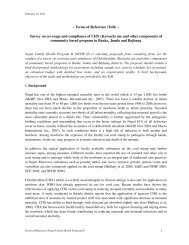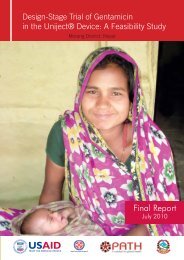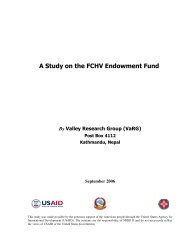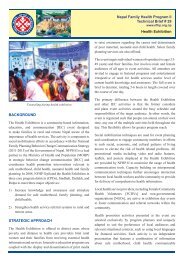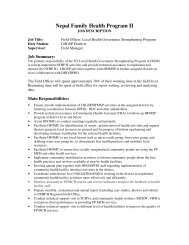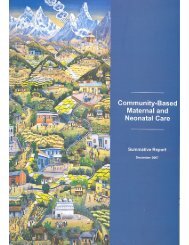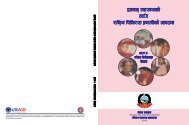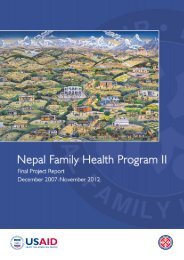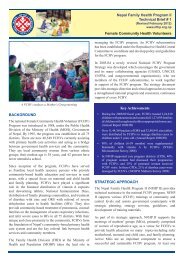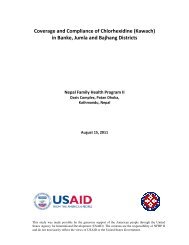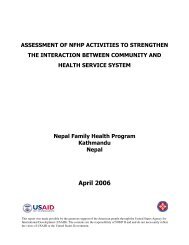Technical Brief - Nepal Family Health Program II
Technical Brief - Nepal Family Health Program II
Technical Brief - Nepal Family Health Program II
Create successful ePaper yourself
Turn your PDF publications into a flip-book with our unique Google optimized e-Paper software.
<strong>Nepal</strong> <strong>Family</strong> <strong>Health</strong> <strong>Program</strong><br />
<strong>Technical</strong> <strong>Brief</strong> #17<br />
Community and <strong>Health</strong> Facility as Partners<br />
Participatory game for team building among members of<br />
the health facility operation and management committee.<br />
BACKGROUND<br />
The foundation of any effective health program is<br />
engaged members of the community. They are<br />
important as users, in mobilizing local resources, and<br />
reaching out to segments of the population which<br />
have not benefited from existing services.<br />
Communities have a right to quality health care and,<br />
at the same time, a responsibility to support<br />
government efforts in developing more effective<br />
community health services.<br />
The vision of the Government of <strong>Nepal</strong> (GON) for<br />
health and development focuses on self-reliance,<br />
community participation, and involvement of the<br />
private sector and nongovernmental organizations<br />
(NGOs). In 1999, the government passed the Local<br />
Self-Governance Act, based on which the Ministry of<br />
<strong>Health</strong> and Population (MOHP) decided to<br />
decentralize health service management to local<br />
bodies. The intention of this initiative was to<br />
encourage local communities to take greater<br />
responsibility in managing local health facilities and<br />
health programs.<br />
Since its beginning in late 2001, the <strong>Nepal</strong> <strong>Family</strong><br />
<strong>Health</strong> <strong>Program</strong> (NFHP) has been involved in<br />
strengthening the interface between communities and<br />
health facilities and service providers. This support<br />
has enabled the community to be more involved in<br />
managing their health programs and services and<br />
thus benefit from local health services.<br />
The <strong>Nepal</strong> <strong>Family</strong> <strong>Health</strong> Project, mainly though its<br />
partners, Save the Children, US (SC/US) and CARE-<br />
<strong>Nepal</strong>, provided support to GoN in the initial formal<br />
hand-over of health facilities to their communities in<br />
its 17 core program districts (CPDs). Nationwide,<br />
this process was conducted in 27 districts and<br />
involved 1433 health facilities. Approximately half<br />
of these (736) were supported by NFHP. Following<br />
this formal process, a three-day capacity assessment<br />
and strengthening training was given to 502 members<br />
of these new <strong>Health</strong> Facility Operation and<br />
Management Committee (HFOMC). In most of these<br />
(422) support also involved use of the “partner<br />
defined quality” (PDQ) approach. This process<br />
involved assessing quality issues from the<br />
perspective of both health facilities and the<br />
community and then jointly prioritizing and<br />
developing action plans. Through these inputs, NFHP<br />
has sought to empower local communities to manage<br />
health services at the community level and strengthen<br />
the partnership between the community and the HF.<br />
In 2006, NFHP assessed its input in this area over the<br />
first five years of the project and learned key lessons:<br />
• Community members (including HFOMC<br />
members and HF staff) were generally not<br />
sufficiently well informed to take up these new<br />
roles as envisioned by the new government<br />
policy. Lack of clarity on the expected functions,<br />
roles and responsibilities of various players (e.g.,<br />
Village Development Committee (VDC), District<br />
Development Committee (DDC) and District<br />
(Public) <strong>Health</strong> Office (D(P)HO) resulted in<br />
some confusion.<br />
• Mere ‘hand-over’ of health facilities to local<br />
bodies did not ensure achievement of the<br />
objectives of this initiative. Once HFOMC<br />
members were provided with support, enhancing<br />
knowledge, skills, and motivation, they were able<br />
to manage their HFs more effectively.<br />
• The hand-over process and strengthening<br />
program and other community mobilization<br />
initiatives need to be understood and<br />
implemented as a process not merely as a series<br />
of events.<br />
• Active linkages between DDCs, D(P)HOs, VDCs<br />
and HFOMCs are indispensable for mobilization<br />
of local resources.
• HFOMCs require technical guidance if they are<br />
to focus to improving health (and health programs)<br />
rather than focusing only on developing<br />
physical infrastructure.<br />
• HFMOC need support and confidence-building<br />
to effectively support Dalit and janjatis (highly<br />
marginalized/ disadvantaged peoples) and<br />
women.<br />
• <strong>Program</strong>s and activities implemented under<br />
different names by different organizations were<br />
working in isolation. Consolidating efforts and<br />
developing an effective common capacity<br />
building package have helped to improve and<br />
streamline services.<br />
To adequately address these issues, more effort is<br />
needed to mobilize community support for health<br />
services and community participation in publicsector<br />
health facilities. Based on lessons learned from<br />
the NFHP study, NFHP further refined its approach<br />
and in the final year has developed a modified<br />
package called Community and <strong>Health</strong> Facility as<br />
Partners (CHFP) which has been implemented in 8<br />
core program districts.<br />
STRATEGIC APPROACH<br />
Community and <strong>Health</strong> Facility as Partners<br />
NFHP’s Community and <strong>Health</strong> Facility as Partners<br />
approach seeks to improve the health of the<br />
community (with special focus on marginalized and<br />
underserved people) by empowering community<br />
members to manage their local HFs and other health<br />
programs. Key features of this approach include:<br />
• Tailoring support that responds to the specific<br />
local situation.<br />
• A focus on social inclusion and good governance.<br />
• Intensive follow-up and monitoring in order to<br />
measure progress and identify opportunities for<br />
improvement.<br />
• A simple, streamlined performance appraisal<br />
system developed for use by HFOMCs, using<br />
simple indicators and scoring system.<br />
• Creating linkages between the DDC, VDC and<br />
HFOMC, which has helped bridge resource gaps<br />
at the local level.<br />
• Dalit/women members are targeted for special<br />
coaching support (see below).<br />
PROCESS<br />
Startup Activities<br />
Eight districts were selected out of NFHP’s 17 core<br />
program districts (CPDs), prioritizing those with<br />
weaker health services performance and lower<br />
human development index status. From each district,<br />
12 to 20 Village Development Committees were<br />
selected for special focus—120 altogether. HFOMCs<br />
in the remaining VDCs continued to receive limited<br />
support.<br />
Once districts and VDCs were selected, all NFHP<br />
field officers and D(P)HO staff were oriented and all<br />
approaches and tools/guidelines were pre-tested<br />
before implementation. Similarly, a central-level<br />
support group consisting of different technical teams<br />
was formed to support program implementation.<br />
District-Level HFOMC Profile<br />
In all program districts, a detailed profile of existing<br />
HFOMCs was prepared to characterize membership,<br />
resource mobilization and organizational capacity.<br />
Two-day Interaction Meetings with HFOMC<br />
A curriculum for a two-day interaction meeting was<br />
developed, based in part on the previous NFHP<br />
approach (HFOMC orientation and strengthening,<br />
PDQ) and in consultation with a wider group of<br />
stakeholders. Two-day meetings were conducted to:<br />
• Inform HFOMC members of their rights and<br />
responsibilities.<br />
• Increase mobilization of local resources in support<br />
of the HF and its health programs.<br />
• Improve social inclusiveness in access to and use<br />
of health services.<br />
Interaction sessions were designed to be very<br />
participatory and responsive to locally identified<br />
needs. Methods used include discussions, meetings,<br />
class room teaching and are tailored to the local<br />
situation.<br />
<strong>Technical</strong> Support Visits<br />
After the 2-day interaction sessions, NFHP field<br />
officers, together with D(P)HO staff, conducted<br />
technical support visits to observe, coach, and<br />
facilitate meetings of the HFOMC. Community<br />
mobilization activities are observed, findings are<br />
shared with health facility staff, and interaction<br />
meetings reported on in HFOMC meetings and on<br />
progress made against action plans. Similar followup<br />
is done in all VDCs, though less frequently in<br />
non-focus VDCs.
Capacity of Dalit and Women HFOMC Members<br />
Though the current composition of the HFOMC is<br />
intended to be inclusive, dalit and women members<br />
have tended not to actively participate. Therefore,<br />
strengthening the capacity of dalits and women<br />
members is given a high priority through assessment<br />
and coaching.<br />
Community Mobilization Activities<br />
During the 2-day interaction meetings, a detailed<br />
action plan is prepared. NFHP provides technical<br />
support to HFOMC members to help implement their<br />
identified priority activities. They have tended to<br />
focus mostly on increasing use of services by those<br />
who are underserved.<br />
Advocacy Meeting at District Level<br />
Advocacy programs with DDC and VDC secretaries<br />
have been organized semi-annually to orient them on<br />
the CHFP approach and to advocate for resource<br />
mobilization for local health services.<br />
HFOMC members participating in 2-day interaction meeting.<br />
RESULTS<br />
As this revised approach has only been implemented<br />
since October 2006, it is still rather early to<br />
determine impact. However, some key achievements<br />
by NFHP and its partners over the preceding five<br />
years include:<br />
• <strong>Technical</strong> input was given to HF staff, HFOMC<br />
members, and other members of the community<br />
during the PDQ process and have contributed to<br />
visible improvements in quality of services and<br />
improved skills and competency in service<br />
delivery, planning, monitoring and supervision.<br />
• <strong>Health</strong> facility staff better understand their own<br />
responsibilities, accountability and the role of<br />
HFOMCs.<br />
• There has been an increased sense of ownership<br />
of HF programs among HFOMC members.<br />
Communities also have frequently been<br />
supportive in improving the physical facilities<br />
of HFs – helping to construct buildings, erect<br />
compound walls, procure furniture and<br />
medicines, make arrangements for water<br />
supply, electrification, etc.<br />
• In a number of HFs, the HFOMC has prepared<br />
a list of poor and marginalized people and has<br />
given authorization for them to receive health<br />
services, including drugs, free of cost.<br />
LESSONS LEARNED<br />
• Local bodies can take longer than anticipated<br />
to pick up all the functions envisioned under<br />
decentralization. To help facilitate this process,<br />
expected roles need to be clearly communicated,<br />
support is needed to build capacity, and the<br />
process must be regularly monitored during the<br />
initial phase. Decentralization needs to be<br />
understood and implemented as an ongoing<br />
process rather than an event.<br />
• <strong>Health</strong> facilities need on-going support after<br />
decentralization. DDCs, VDCs, and<br />
municipalities generally have not given sufficient<br />
support to health facilities once they have been<br />
handed over to local boards. There is a need to<br />
further develop capacity of these local boards.<br />
• A continuous focus on quality is critical. Most<br />
HFOMC meetings have focused on issues of<br />
drug purchase, infrastructure development and<br />
human resources. Important as these issues may<br />
be, they have overshadowed health programs and<br />
provision of quality health care services.<br />
• Targeted support for marginalized populations<br />
is key. Regular coaching for dalits and<br />
female members on their roles and responsibilities<br />
has been very productive. The scale of<br />
such capacity building measures needs to be<br />
increased.<br />
• Self-assessment by HFOMCs is helpful not<br />
only in helping to orient their work, but also<br />
in building self-efficacy thus promoting longterm<br />
sustainability.<br />
CHALLENGES<br />
• In the current political environment, in which<br />
there is an absence of locally elected bodies,<br />
VDC secretaries have been chairing meetings of<br />
the HFOMC. As they are government officials<br />
who, in many cases, are not fully integrated in<br />
the communities where they are based, this has<br />
undermined local HFOMC members taking a<br />
significant leadership role.
• In the coming year or two, there is a possibility<br />
of revival of local governments and restructuring<br />
of HFOMCs. New members of local government<br />
will need to be orientated.<br />
• There are many stakeholders—governmental and<br />
non-governmental—participating in handover<br />
and in implementing decentralization. These<br />
organizations need to work together coherently<br />
to avoid duplication and confusion.<br />
This technical brief is one of a series seeking to capture key lessons learned from the USAID/ <strong>Nepal</strong> bilateral<br />
project, the <strong>Nepal</strong> <strong>Family</strong> <strong>Health</strong> <strong>Program</strong> (367-00-02-00017-00), 2001-2007. The document was produced with<br />
support from the American people through the U.S. Agency for International Development.<br />
The views expressed in this document do not necessarily reflect those of USAID.<br />
The <strong>Nepal</strong> <strong>Family</strong> <strong>Health</strong> <strong>Program</strong> is implemented by JSI Research & Training Institute, Inc.,<br />
in collaboration with Engender<strong>Health</strong>, JHPIEGO, Johns Hopkins University/ Center for Communication <strong>Program</strong>s<br />
(JHU/CCP), Save the Children, <strong>Nepal</strong> <strong>Technical</strong> Assistance Group (NTAG), Management Support Services (MASS),<br />
<strong>Nepal</strong> Fertility Care Center (NFCC) and, for a period, CARE and ADRA.



